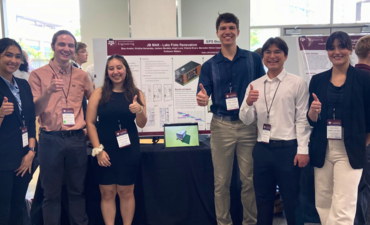
I was at the playground with my daughter one Saturday morning, when I received a text message from our project engineer that read: Does this look safe?
The millwright was rigging a heavy, expensive, long-lead piece of equipment with a forklift. Low overhead utilities limited the rigging options. The photo immediately reminded me of my rock climbing days and the "American Death Triangle."
My response: Don't allow them to lift that equipment. The rigging angle is extreme. The forces are magnified substantially. Their foreman needs to check rigging angles, force magnification and rigging/pick point capacities.
After comparing notes, theirs from their rigging manuals and mine on the sidewalk with my daughter's chalk, we determined the shackles and pick points were adequate for the magnified load. The pick was successful.
That situation could have ended differently. If the loads were slightly higher or the angles were slightly more exaggerated, the capacity of the shackles would have been exceeded. There could have been a rigging failure, the equipment could have been damaged, and somebody could have been hurt or killed during the lift. The crew did not follow fundamental rigging procedures by skipping their calculations before executing the lift. Thankfully, a young project engineer wasn't comfortable with what she saw and asked the right question.
How does someone learn to ask the right questions? Experience and education are the answer.
Experience
Purely based on its definition, experience takes time. We all need "time in the saddle" to observe outcomes, both positive and negative. Those experiences lead to better choices and the ability to identify and manage risks. It often takes the better part of a career to gain significant experience in our industry.
I was recently asked to participate in a ski race from Crested Butte to Aspen in the Elk Mountain range of Colorado. This is a 40-mile race that includes nearly 7,000 feet of vertical elevation gain. It starts at midnight when avalanche danger is lower because temperatures are nearing their coldest. Before officially deciding whether to participate, I consulted a trusted friend who has 50 years of experience competing in similar events. He responded in two sentences: "Mark Twain said that 'good judgment is the result of experience and experience the result of bad judgment.' Don't do the race." He had his share of bumps and bruises and close calls. I trusted him and he deemed the race a risky endeavor based on my current training and skillset. I did not do the race.
Personally and professionally, we can all remember examples where we learned our lesson after making mistakes. In the construction profession, mistakes can be costly and dangerous. We can't afford to allow our teams to gain experience through bad judgment. In many cases, education can accelerate the time it takes to gain experience and will reduce risks along the way.
Education
On a recent project, there was a coordination issue with the waste line exiting the building. A young engineer, who ran the coordination meetings and was very savvy in modeling, identified the issue. Being a gravity system, there were several constraints to consider when moving the line. The project team, including the general contractor and several key specialty contractors, decided to move the waste line in the model and penetrate through the bottom of the grade beam. The change was incorporated into the concrete lift drawings and sent to the crews to form and place the grade beam with a large sleeve for the waste line. Before work began, the superintendent reviewed the lift drawing and immediately asked the structural engineer if it would be acceptable to penetrate the grade beam near the bottom with such a large sleeve. The answer was simply, "No." Penetrating the grade beam was a significant structural concern due to the tensile forces at that location. The waste line was in an acceptable location when viewed in isolation, but not when other systems were considered. Thankfully, the superintendent knew (from experience and/or education) the right question to ask. Subsequently, he took the time to teach a lesson to the young engineer who was running the coordination process.
Education can come in the form of informal mentoring as described in the previous example. There are exceptional people who are properly trained and have a knack for teaching others. However, some people with years of experience are not properly trained and their teaching perpetuates improper and sometimes dangerous practices. Experienced people on a jobsite are often too busy to provide proper mentorship. That is where formal education needs to come into play, particularly for people entering the construction industry.
Newcomers in the construction industry spend an extraordinary amount of time trying to understand the complexities of a modern construction job. It takes a decade or more to learn the fundamental materials and systems required to complete a project."
Newcomers in the construction industry spend an extraordinary amount of time trying to understand the complexities of a modern construction job. It takes a decade or more to learn the fundamental materials and systems required to complete a project. A comprehensive course is not taught at our universities. So, where does an intern or new engineer find the answers to such questions today? Their first stop is either Google or YouTube. Searching on the internet is an excellent way to find a restaurant or to get directions, but it is no way to learn the materials and systems in a construction project. Precision and accuracy are too important. We are giving our young professionals an enormous amount of responsibility in this booming construction market. People are rising through the ranks faster than ever before, and the risks are simply too high to not equip them with the tools needed to lead our construction projects.
Project leadership should make educating their team a priority. Let's give our newcomers in the industry the tools to ask the right questions and make positive impacts on our jobsites. We cannot expect positive outcomes without playing an active role in their development. They will eventually gain experience through mistakes, but that is costly and takes a significant amount of time. Formal and frequent education opportunities are imperative.
As it relates to building construction projects, Construction-Education.com was founded to fill the knowledge gap and educate industry professionals. Online courses have been developed to boil down years of on-the-job training into hours of high impact classes. "How a Building is Designed and Built" was developed and taught at the University of Colorado Boulder for seven years before it was published online. It covers the design and construction process for every major material and system in a building. Thousands of building construction professionals have taken these courses to accelerate their careers. Additionally, each sector of the construction industry has formal training available online and in-person through various professional organizations (ASCE – https://www.asce.org/continuing-education/, ASME – https://www.asme.org/shop/courses/asme-training-development, AGC – https://www.agc.org/learn/education-training, etc.) and several university programs.
This article was written by a Southland Industries team member.




